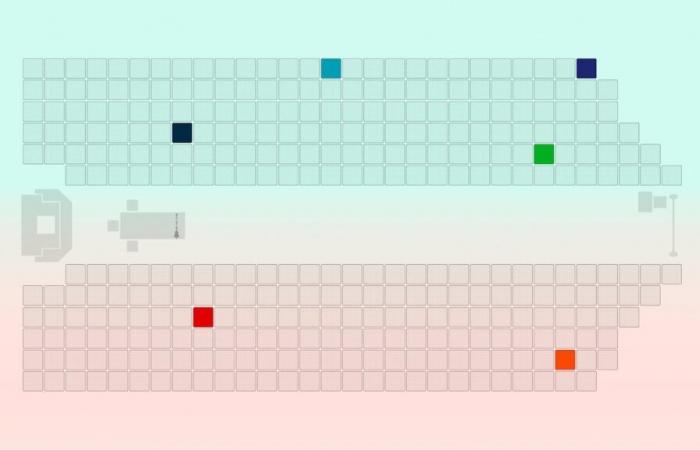In 2016, a committee was mandated by the House of Commons to reform the voting system after Justin Trudeau had made the promise. The objective: to ensure that “each vote matters”.
Three options have notably been studied to replace the majority uninominal ballot in a turn, accused of creating a political distortion and of discouraging electoral participation.
The majority uninominal ballot in a turn
This is our voting system. It is used in all federal elections since the Confederation, in 1867. But his aura has pale since several parties competed for the votes. He is accused of moving away from the Popular will and of disadvantage the smallest parties.
In addition to the 169 seats collected by the Liberal party (PLC), the official opposition formed by the Conservative party (PCC) obtained 144 of the 343 seats. It was 42 % of the room, the equivalent of the votes he obtained.
The Bloc Québécois (Bq) Also, with 22 deputies (6.4 %), reached a very similar result to the popular vote which was granted to it, or 6.3 %.
It’s for the new Democratic Party that the gap widens. His tumble has allowed him to elect only 7 deputies to the greatness of the country. It is three times less than the BQ with the same share of the popular vote (6.3 %).
As for Green partyhe only elected one deputy, 0.3 % of the room with 1.2 % of the votes cast.
Canada has 343 constituencies, all represented by a deputy.
With the majority of uninominal in a turn, the plurality of the votes is enough to be elected, not the majority (more than 50 %). Then, the party having managed to elect the greatest number of deputies made up the government and obtained control of the House of Commons.
His detractors deplore that he only counts the votes attributed to the winner, even if he obtains less than all his opponents together. The number of seats obtained by the government and the other parties is therefore very often far from the popular vote.
It’s different this year, notes researcher Mercédez Roberge, expert in the voting system. The strong harvest of the PLC and the PCC (85 % of the popular vote) and the tumble of the small parties (which share the rest) were transposed into a number of elected officials after all proportional on the national scale. “It doesn’t mean that the other parties are treated fairly,” she notes. The PLC and the PCC have not too disproportionate results in front of each other, but remain over -represented compared to the NPD. It puts the appearance of equity into perspective this year. »»
Especially since the distortion remains present at the province’s scale, in regions acquired to certain parties, such as the Atlantic for liberals and meadows for conservatives.
The Gallagher index is used to measure the distortion level between the votes obtained and the seats that each part of the parties finally occupies. The higher it is, the less the voting system is deemed proportional.
We target an index of 5 or less.
Simulations limits
We will simulate the results of the federal election in three other voting methods.
That said, there are as many scenarios as possible results, since established parameters and calculations (see methodology) are not based on models already pre -established for Canada. Recall that with a different voting system, parties’ strategies and the behavior of voters probably also differentiate.
The transposition of the results of Monday, however, makes it possible to note how a different voting system could have made it possible to alleviate the distortions of the vote and to bring the popular will to the number of seats obtained by each of the parties.
Preferential vote
This is what Justin Trudeau would have liked if he had been able to carry out his reform of the voting system as he was considering. But, in the absence of consensus, the former Liberal Minister preferred not to impose it. It is once again a majority ballot system.
To the preferential vote, the PLC would not only have kept power, but also exceeded the majority with 8 more deputies (177 out of 343).
This gain of liberals would be at the expense of PCCwhich would have lost 10 deputies (134 rather than 144), and BQwith 4 less (from 22 to 18).
But the NPDhe would have doubled his presence in the House, with 14 deputies instead of 7. As for PVChe would have lost his only seat.
With this voting system, an voter does not choose only one candidate: he number them rather in order of preference on his ballot.
If a candidate obtains the majority of votes (more than 50 %) at the first count, he is elected. Otherwise, the last rank candidate is eliminated and his votes are redistributed to candidates of 2e choice which appeared on its ballots. And so on, until a deputy was elected with the necessary majority.
It has the advantage of resembling our current voting system, but it does not allow more to ensure a distribution of seats proportional to the popular vote.
It’s even worse, estimates Mercédez Roberge, even if the result of the election has led to the distortion this year. The fact remains that the Liberal Party is over -represented, unlike others.
Moreover, the PLC often comes out of the preferential vote, since it is 2e Traditional choice of voters with other political affinities.
-He is therefore still criticized for promoting the main political parties, to the detriment of the little ones, which tears up from pain and misery some seats, notes the expert.
Mixed proportional representation
It is the voting system often mentioned to replace ours, since it retains the majority voting forces, but with better proportionality of the results. Quebec also considered it before abandoning its own electoral reform.
With a proportional voting system with compensation, the PLC would have been elected 156 deputies, or 13 less, and would have even further removed from a majority.
Can PCC can BQ would not have made major gains: they would have obtained 148 (+4) and 23 seats (+1).
Compensation would have benefited above all in NPDsince he would have more than doubled his number of elected officials (15 rather than 7).
The PVC would have kept its only deputy, but would not have obtained compensation seats. Ditto for the Popular party (PPC), having not reached the necessary threshold of 5 % of the popular vote.
The mixed proportional representation provides two votes: a first to elect a deputy in a constituency at the redefined borders and a second for a party, in order to grant compensation seats in proportion to the votes obtained.
His supporters see it as the best of both worlds. It maintains the geographic link between voters and their deputies, since part of them are elected as Today. List deputies, who make up the balance of the deputation in the House of Commons, for their part ensure greater proportionality of the results.
This is the voting system for which Mercédez Roberge militates. “Of the three models are the most interesting,” she says. It also has the advantage of better representing the smallest political parties, adding compensation to the won district seats.
“It has its advantages, but is not miraculous, however,” she relativizes. The idea is not to arrive at the lowest distortion index, but that of a model that does not bring any particular problems “in the representation of parties in the chamber.
Single transferable vote
This time, we navigate between the preferential vote, by ordering the candidates of his choice, and the proportional, since more than one seat can be at stake in constituencies with extended borders.
With this voting system, the PLC would go from 169 to 163 seats and would remain at the head of a minority government. THE PCCwith 141 deputies (rather than 144), would still form the official opposition.
The BQ would make two gains (24 elected officials instead of 22), while the NPD managed to slow down his fall by electing 15 deputies (8 more).
Except that the PVChe would lose his only representative. THE PPC Also would not be able to enter the House of Commons.
The distribution of votes differs slightly from the preferential vote. The deputies are elected when they reach a quota, determined by the number of valid voting bulletins and seats to be filled by multinominal constituency.
If other seats must still be filled, the candidate in the last rank is eliminated and his supports are redistributed to his opponents, still according to the principle of 2e choice. And so on until all the seats at stake is provided.
The small parties which win a small number of seats are generally disadvantaged by the single transferable vote, as for the preferential vote, notes Mercédez Roberge, which brings a downside to our simulations.
“This exercise has its limits, she suits, because people would have voted differently” with another voting system. This reality also applies to the three scenarios.
An impression of deja vu
The reform of the voting method has been part of the public debate for more than a century.
In the Federal, various committees studied the question eight times and as early as in 1921, where more than two political parties were in the running for the first time. It then became difficult for a candidate to obtain more than 50 % of the vote. We had proposed to establish a preferential vote in the constituencies with more than two candidates.
Subsequently, other committees in turn supported the status quo or a form of mixed proportional representation to better represent the interests of Canada. This was as recently as in 2004.
In 2007, consultations on the subject, carried out on a country scale, rather revealed that Canadians would prefer the current electoral system inherited from the British tradition, but that they were still open to a change.
Less than a decade later, the Liberal Party, then led by Justin Trudeau, returned to the charge by making the reform of the voting system a campaign promise in 2015. We then had to live the “last” election according to the uninominal majority ballot in a turn.
But the idea of reforming the voting system was abandoned less than two years later, for lack of consensus around a specific electoral system.
Today, only the new Democratic Party and the Green Party still include their electoral program a desire to “repair the defaulting electoral system of Canada” with a mixed proportional system “so that each vote counts”.
It is said, however, that there is no perfect electoral system, each advocating different values and which can advantage or disadvantage one or the other of the parties which aspire to govern from one election to another.








